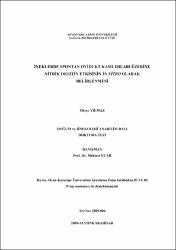İneklerde Spontan Ovidukt Kasılımları Üzerine Nitrik Oksitin Etkisinin İn Vitro Olarak Belirlenmesi
Abstract
The objective of this study was to determine the effect of nitric oxide (NO) on
spontaneous contractility of oviduct of cows in different sexual cycle in vitro and to
reveal the expression models of nitric oxide synthase enzymes.
The oviducts (n:88) of 64 Holstein cows obtained from private slaughterhouse
were evaluated. Animals were separated into four groups as metestrous, early
diestrous, late diestrous and follicular phase, then blood samples were taken to define
progesterone (P4) and NO concentration.
Longitidunal and circular isolated strips of isthmus and ampulla of oviducts of
cows (n:40) placing on the same side of ovary with luteal structure were prepared for
isolated organ bath experiments. L-arginine, Nitro-L-arginine-metil-ester (L-NAME)
+ L-arginine and methylene blue (MB) + L-arginine were applied to the tissues to
determine endogenous NO effect and sodium nitro prusside (SNP) was used to
determine exogenous NO effect. The expression of NOS isoforms in isthmus and
ampulla parts of oviducts of 24 cows were evaluated for immunohistochemical
staining, RT-PCR and Western blotting, but also both oviducts of these cows were
used for Western blotting.
In isthmus, it was observed that L-arginine did not alter contractile tension in
longitidunal smooth muscle tissues in late diestrous and follicular phase groups and in
early diestrous in circular muscles, but raised in other groups. In ampulla, it was
determined that contractile tension was not changed not only in longitidunal strips in
late diestrous but also in circular smooth muscle tissues in late diestrous and follicular
phase. In other groups, the contractile tension was increased.
By using L-arginine applied after L-NAME, it was seen that contractile tension
was not changed or increased in metestrous, late diestrous and follicular phase in
longitidunal and circular smooth muscle tissues both in isthmus and ampulla.
However, it was decreased in early diestrous in longitidunal strips but not changed in
circular smooth muscle tissues. In addition, by using L-arginine applied after methylene blue (MB), the contractile tension was not changed or decreased in early,
late diestrous and follicular phase, was not changed or increased in metestrous.
In longitidunal smooth muscle tissues of isthmus, it was determined that
contractile tension was decreased in metestrous and follicular phase groups, but was
not changed in early diestrous and increased in late diestrous groups, by using sodium
nitro prusside (SNP). Beside this, in circular smooth muscle tissues, contractile
tension was decreased in metestrous, early diestrous and follicular phase groups and
was not changed in late diestrous by SNP. In longitidunal and circular smooth muscle
tissues of ampulla, SNP was not effective on contractile tension in early and late
diestrous groups while the tension was decreased in metestrous and follicular phase
groups by SNP.
Immunohistochemically, in all groups endothelial NOS (eNOS) expression in
isthmus and ampulla was observed in endothelium on blood vessels in serosa,
muscular layer and lamina propria and epithelium. Neuronal NOS (nNOS) had a
positive staining in epithelial cells and nerve fibres in serosa, muscular layer and
lamina propria. In epithelial layer of isthmus and ampulla, it was seen that eNOS
reaction was strong in metestrous, moderate in follicular phase and weak in other
groups, while nNOS reaction was strong in isthmus and moderate in ampulla in
metestrous and follicular phase groups. Positive staining of nerve fibres was observed
mostly in metestrous and follicular phase groups. In all groups eNOS, nNOS and
iNOS isoforms were detected by RT-PCR. In Western blotting, eNOS and iNOS
proteins were evident in ipsi-contra lateral oviduct whereas nNOS was undetectable.
In conclusion, it was suggested that NO had no effect on spontaneous oviduct
contractility in cows in vitro, this effectiviness was not due to NOS enzyme activity
however, hormonal status could change the NOS enzyme activity and NOS / NO
pathway could play a role in secretory and ciliary functions, but not in contractility in
oviduct.
Collections
- Doktora Tezleri [154]



















